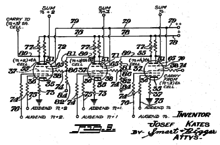
The Additron was an electron tube designed by Dr. Josef Kates, circa 1950, to replace the several individual electron tubes and support components required to perform the function of a single bit digital full adder. Dr. Kates developed the Additron with the intention of increasing the likelihood of success and reliability while reducing the size, power consumption and complexity of the University of Toronto Electronic Computer, (UTEC)[1]
The Additron neither went into production at the Canadian Rogers Vacuum Tube Company, where the prototypes were built, nor was it used in the UTEC machine. It did make a widely publicized appearance at the 1950 Canadian National Exhibition operating an electronic game of Tic-Tac-Toe, dubbed Bertie the Brain, to show the marvels of electronic computing.
The tube was registered with the Radio Television Manufacturing Association [2] on 20 March 1951 as type 6047.[3] [4] [5] [6]
YouTube Encyclopedic
-
1/3Views:723 929332 611663 210
-
Adding three digit numbers with regrouping | Addition and subtraction | Arithmetic | Khan Academy
-
Alternate mental subtraction method | Addition and subtraction | Arithmetic | Khan Academy
-
Addition 4 | Addition and subtraction | Arithmetic | Khan Academy
Transcription
We have three different addition problems right over here. And what I want you to do so you get the hang of things is to pause the video and try them on your own. But as you do them, I want you to really keep in mind and think about what the carrying actually means. So I assume you've tried it on your own. Now I'll work through them with you. So we have 9 plus 6. 9 ones plus 6 ones. Well 9 plus 6 is 15. Well, we can write the 5 in the ones place, and then we can carry the one. But what did we just do? W.hat does this 1 represent? Well, we put it in the tens place-- one 10 represents 10. So all we've said is that 9 plus 6 is equal to 10 plus 5. Is equal to one 10 plus 5, which is equal to 15. Now, in the tens place, we have 1 plus 0 plus 9 which is 10.. So we can write 0 and carry the 1 1 plus 0 plus 9 is 10. Now what does that really mean? Well this is 1 ten plus 0 tens plus 9 tens, which is 10 tens. 10 tens is 100. Or another way to think about 100, it's 1 hundred, and 0 tens. So that's all that carrying represents. So now we have a 1, plus a 7, plus a 9. That is going to be 17. Now we have to remind ourselves, this is in the hundreds place. This is actually 1 hundred plus 7 hundred plus 9 hundred 17 hundred. Or 1 thousand, 7 hundred. And of course we have this 5 here. And we are done. Now let's try to tackle this one. Now the reason why I wrote it that way is to make sure that we remind ourselves to align the proper places under the appropriate places. So this we rewrite as-- let me do that same green color-- we could rewrite this as 373 plus-- we want to write the ones place under the ones place, and the tens place under the tens place, so that we're adding the appropriate values. So 3 plus 8 is 11. The 1 in the ones place, and the 1 in the tens place. 10 plus 1 is 11. 1 plus 7 is 8. 8 plus 8 is 16. This is actually 16 tens. So let me just write down the 16. What is 16 tens? Well, that's 160. So this 6 is a 60, and then I have a hundred. 1 plus 3 is 4. But these are actually hundreds, so it's 4 hundreds. So we get 461. Now finally, 9 plus 3 is 12. 2 ones, and 1 ten. 12 is the same thing as 10 plus 2. Now in the tens place, 1 plus 4 plus 9 is 14. So we write the 4, and carry the 1. But remind ourselves this is actually 10 plus 40 plus 90, which is 140. Which is the same thing as 40 plus 100. And then 1 plus 1 plus 2 is 4. But this is the hundreds place. So this is actually 1 hundred, plus 1 hundred, plus 2 hundred, or 4 hundred. And we're done.
Patents
References
- ^ Vardalas JN (2001). The Computer Revolution in Canada MIT Press, ISBN 0-262-22064-4
- ^ RTMA Engineering Department, Release #951, 20 March 1951
- ^ "6047 data sheet, RTMA Engineering Dept. Release #954" (PDF). Rogers Majestic Corp. March 20, 1951. Retrieved 14 August 2016.
- ^ Sibley L (2007). Weird Tube of the Month: The 6047 Tube Collector 9 (5):20
- ^ Osborne CS (2008).The Additron: A Binary Full Adder in a Tube Tube Collector 10 (4):12
- ^ "Binary Adder Tube for High-Speed Computers" (PDF). National Union Electric. September 1955. Retrieved 9 March 2021.
